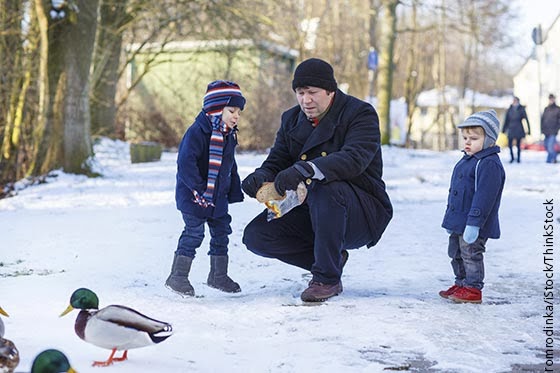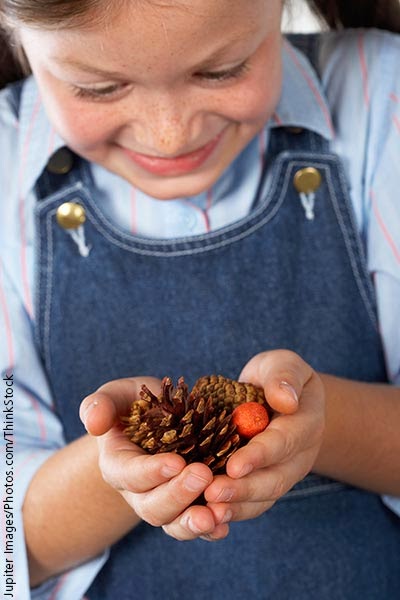Many of us are somewhat removed from nature in our everyday lives. This is especially so during the winter. Yet despite winter’s chillier and shortened days, along with busy school and extracurricular schedules, most families can find some time during a typical week to enjoy the outdoors.
Nature play has been linked to many aspects of physical and psychological health for people of all ages. In addition, getting outside is just plain fun. Nature experiences help families bond and add richness and wonder to our lives. Here are some ideas for getting out and enjoying nature this winter.
Keep a moon diary
Taking note of the moon’s phases and rhythms as it moves through its cycle is a fascinating exercise and a great way to observe nature’s rhythms. It can also help younger children understand the monthly calendar.
Look at the moon each night after it has risen and record its phase, in writing or drawing, as it makes its monthly rotation around the earth. The amount of moon we see is really the amount of sunlight that is reflected on it during each phase. The moon always follow this pattern: New, waxing crescent, first quarter waxing gibbous, full, waning gibbous, third quarter, waning crescent, new. Learn more about the moon by reading 10 Surprising Lunar Facts.
Gaze at the stars
Despite chilly nights, winter skies can be the clearest of the year and the richest in stars. Begin to get to know the winter night sky by locating a few key constellations, such as the prominent Orion. Orion’s Belt is made up of blue-white Rigel at the top end and reddish Betelgeuse at the bottom. If you follow a line from Betelgeuse, down and to the left, you will locate a bright star called Sirius, or the Dog Star. Use these key stars to locate still more as you continue to observe the night sky. Consult a star chart, or this astronomy site.
Play tag in a park or playground
You don’t have to go far to have fun outdoors. Sometimes the “nearby nature” of a local playground or park provides the perfect setting for family exercise and fun.
There are so many fun tag games so you needn’t limit yourself to basic tag. Teach your children tag games you remember from childhood, or try this variation:
Blob Tag
Once a player is tagged by the person who is “it,” the two join arms and become a blob, which chases players together to try to tag them. Other players who are tagged also join arms and become part of the blob. Some play a version in which a blob of four splits off to become two new blobs. The last person standing alone becomes the new “it.”
Make a Valentine bird feeder
Sometimes we forget to feed birds and other wildlife in the winter, which can be precisely when they need food the most because it’s less plentiful in the environment. This is a fun, easy project that encourages bird watching. Experiment with different kinds of seeds to see which birds each attracts. Or ask for advice at a plant nursery or pet store. Oil sunflower is a particularly nutritious winter seed that a lot of birds like.
You’ll need:
- Cardboard
- Heart template, optional
- 2-3 ‘ ribbon or string
- ½ cup vegetable shortening, peanut or other nut butter, suet, or lard (plus, cornmeal or oatmeal, optional)
- 2 ½ cup mixture of birdseed (chopped nuts, dried fruit, optional)
- Small mixing bowl
- Plate, shallow dish or pie tin
- Scissors
- Spoon or butter knife
- Cut a heart out of cardboard, using a template or free hand.
- Poke a hole toward the top and run the string through it. (If using a ribbon, you might want to string it after the mixture has dried a little, using a hole to poke through the hole, as needed.)
- In mixing bowl, combine peanut butter or other spread with optional meal.
- Spread that mixture over the both sides of the heart with the knife or spoon.
- Pour the birdseed and feed ingredients onto the plate.
- Place the heart into the seeds.
- Hang your Valentine from a tree branch or window eave that offers some shelter from wind and weather and a view of visiting birds.
Observe and monitor birds
Do you enjoy observing nature and have 15 minutes to spare? If so, you can be a citizen scientist. Over the past few years, citizen science has really taken off, allowing ordinary people to help scientists and organizations track the count and behaviors of birds, butterflies, bees, wildflowers, weather, and much more. Researchers can’t be everywhere, and many of us have habitats in our backyards and neighborhoods that can help others gain important information about nature. Don’t let the name intimidate you. All you need to participate in citizen science is the desire to observe nature to the best of your ability for a period of time and record what you see.
Want to monitor other wildlife and natural phenomena? There are many other wonderful citizen science projects that can use your help.
Take a photography or poetry walk
Sometimes the act of recording your observations with a camera or journal causes you to look around in a different way and notice things and make connections that you might not have made otherwise. Photography and poetry can help us quiet ourselves and focus our time in nature.
If your child is struggling to record thoughts, try asking open-ended prompts: “What does the hawk’s flight remind you of?” or “What do those rustling leaves feel/smell/look/sound like?” If they’re taking pictures, try to encourage them to stop and notice small things, like bugs, footprints, buds in bloom, interesting colors, or angles of light. You may be surprised at some of the things everyone observes once they are quiet in nature.
Make pine cone folk
On your next outdoor walk, collect pine cones and make fun pine cone people.
You’ll need:
- A variety of pine cones
- Acorns with caps intact, for heads
- Glitter, pipe cleaners, twigs, small pieces of yarn, popsicle sticks, toothpicks, fabric, felt or lace scraps, beads, markers, paint, paper, and other decorative items
- Hot glue or craft glue
Glue the acorn head onto the pine cone body and let dry slightly.
Decorate as desired. Here are some ideas:
- Glue twig or pipe cleaner arms, approximately 2” each, to the pine cone.
- Draw or paint a face on the acorn, or glue on beads for eyes and a nose.
- Decorate the pine cone with a glitter, beaded, or lace “dress.”
- Make a hat out of a cone of paper.
- Wrap a piece of yarn around the neck for a scarf.
- Attach felt shoes to the bottom of the pinecone and felt mittens to the pine cone’s arms.
- Glue two Popsicle sticks to the bottom of the pine cone for skis. Cut two small disks of felt and pierce each with a toothpick. Glue the toothpick ski poles, with the felt toward the bottom, to the pipe cleaner arms.
Create ice art
If winter’s freezing weather has you thinking you can’t play outside, think again. There’s simple fun to be had by creating ice sculptures or ice art. Gather a variety of empty containers with large openings, such as milk cartons, juice boxes, and disposable cups and bowls. Collect rain or water in your containers and color with food coloring, if desired. Leave the containers of water outside to freeze. Carefully remove your containers to reveal your ice sculptures.
Not cold enough where you live? No problem. Have fun making ice sculptures in your freezer! Here are some more ideas for ice art.
Make a root viewer
For many, the roots of a plant can be just as fascinating as the parts we see aboveground. This simple root viewer lets budding botanists view the magical processes that happen below the surface of growing things.
You’ll need:
- Clear plastic cups, bottles or jars
- Seeds and dirt
- Fill the containers most of the way with dirt.
- Plant the seeds close to one side, one or two per cup.
- Put them in the sun and water gently.
- Watch as roots form and plants sprout.
Enjoy the wonders of nature in winter.
Susan Sachs Lipman (Suz) is the author of Fed Up with Frenzy: Slow Parenting in a Fast-Moving World, which contains 300+ activities for family fun and grew out of her blog, Slow Family Online. Slow Parenting and the book were named a 2012 Top 10 Parenting Trend by TIME Magazine. Suz has written for the New York Times’ Motherlode blog, the Christian Science Monitor’s Modern Parenthood blog, and many other outlets. She is the Social Media Director for Parents Place, as well as Bookboard digital children’s library.


